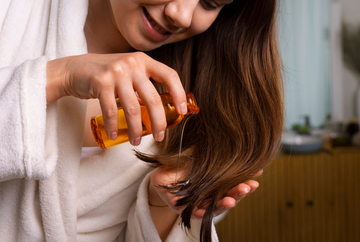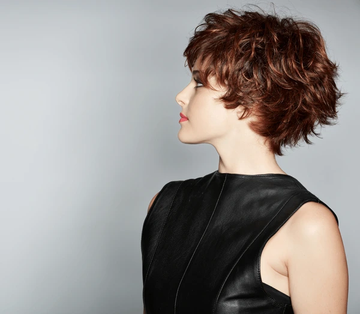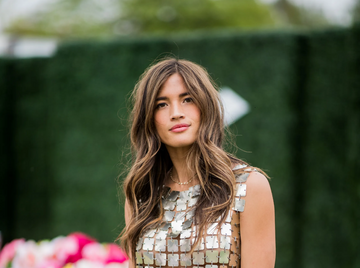A nighttime hormone walks into your haircare routine…
We’ve all been lowkey obsessed with Kourtney Kardashian’s Lemme Sleep supplements. Like, one berry-flavored gummy and suddenly you're wrapped in the best sleep of your life? Sold. But what if we told you that same magical ingredient behind your 8-hour snooze fest is now sneaking its way into your hair routine?
Yep. Topical melatonin for hair is officially having a moment—and no, it’s not a dream (although it is kind of dreamy). This trend is taking over TikTok, slipping into your serums, and popping up in derm-approved scalp sprays. And the buzz? Totally valid.
Turns out, melatonin isn’t just for better sleep—it’s also showing major promise in the hair growth department. We’re talking less shedding, fuller roots, and longer, stronger strands. All while you’re sleeping. Because of course beauty sleep is getting a glow-up.
So, if your hair’s been thinning, breaking up with your edges, or just vibing in a “meh” era, consider this your official invite to the melatonin-for-hair club. We’re jumping into the science, the benefits, the how-to, and why your scalp is (quietly) screaming for this growth booster.
What is melatonin and why is it in my hair products now?
We all know melatonin as the go-to sleep girlie. It’s the stuff inside all the best sleep gummies, and yes—it totally helps you clock that 8-hour beauty-sleep snooze. But what’s the deal with melatonin popping up in hair serums and scalp sprays?
Let’s break it down.
First of all, what even is melatonin?
Melatonin is a naturally occurring hormone your body produces (in the pineal gland, if you’re feeling nerdy) to help regulate your circadian rhythm—aka your body’s internal sleep-wake cycle. It increases in the evening to help you drift off, and dips in the morning when it’s time to rise and shine.
But here’s the juicy part: your scalp actually has melatonin receptors, and when they’re activated, they can do some serious good for your hair follicles.
What does melatonin do for your hair?
Turns out, melatonin is kind of a multitasking queen:
- Extends the anagen phase (that’s the active growth phase of your hair cycle)
- Fights oxidative stress (read: protects your scalp from UV, pollution, and hot tool damage)
- Reduces scalp inflammation (if your roots have been red, itchy, or stressed out)
-
Supports follicle health long-term, helping reduce hair loss and encourage thickness
While we thought melatonin was just for sweet dreams, the latest research says otherwise—it’s here for your scalp health and strand strength, too.
Why topical?
Sure, you could pop a melatonin supplement—but rubbing it directly into your scalp is where the magic really happens. When used as a topical treatment, melatonin can go straight to your follicles, bypassing your digestive system and doing its thing right where it counts.
TL;DR: Melatonin isn’t just a sleepy-time supplement anymore—it’s the lowkey powerhouse ingredient turning up in haircare for a reason. It’s science-backed, growth-friendly, and giving major main character energy.
Why your scalp is obsessed with topical melatonin
Your scalp is high-key underrated. It’s the root (pun intended) of every good hair day, yet often gets ignored in favor of lengths and ends. But if your strands aren’t thriving OR surviving, chances are your scalp needs some TLC—and topical melatonin might be the ingredient it's been waiting for.
Unlike traditional oils or heavy treatments that just sit on top, topical melatonin penetrates deep into the skin barrier and connects directly with hair follicle receptors. These receptors respond by keeping your hair in its anagen phase (the active growth stage) for longer. That means: less fall-out, more density, and strands that feel fuller and stronger over time.
Here’s what makes melatonin a scalp-care so good
- It’s anti-inflammatory: Dry, tight, or irritated scalp? Melatonin helps cool that drama down.
- It’s antioxidant-rich: Think of it like a shield against pollution, UV rays, and everyday damage.
- It’s cycle-supporting: Melatonin works with your body’s natural rhythms to keep your scalp balanced and growth-ready.
- It works while you sleep: This is a treatment that vibes with your downtime—no midday re-application, no greasy roots, no hassle.
And it’s not just a TikTok trend, either. Clinical studies (like this one) have found that applying topical melatonin for hair growth can improve hair density and reduce hair loss in both men and women. Some trichologists even recommend it as one of the best topical melatonin for hair loss options on the market—especially when paired with other actives like caffeine or biotin.
In short? Your scalp likes melatonin a lot. And when used consistently, it might just get you back to your best hair yet.
Hair loss? This might help
Hair loss is the ultimate buzzkill. You’re brushing your hair, minding your business—and suddenly, your strands are shedding like it’s fall and you’re a tree. But here’s the most important part: not all hair loss is created equal, and neither are the solutions.
While topical melatonin for hair loss is blowing up right now, it’s not a cure-all—and we’re not here to sell magic potions. If your hair loss is genetic, a.k.a. androgenetic alopecia (thanks, family tree), melatonin probably won’t reverse it completely—sorry babes. But if you’re dealing with temporary, hormonal, or stress-induced hair loss, this could actually be your growth comeback moment.
Here's where melatonin steps in:
- Telogen effluvium (aka that thing where your hair falls out after stress, illness, or giving birth): Melatonin helps support the follicles and calm inflammation.
- Inflammation-related thinning: If your scalp is irritated, itchy, or red, melatonin’s anti-inflammatory benefits help create a healthier environment for growth.
- Scalp barrier damage: Harsh styling, bleaching, or product overload can mess with your scalp’s balance—melatonin helps protect and reset.
- Circadian rhythm disruption: Yup, your hair has an internal clock too. Melatonin helps regulate it, especially if your sleep or stress levels are out of whack.
In these cases, topical melatonin for hair loss works by supporting the scalp, reducing oxidative stress, and keeping your follicles in their growth phase longer. It’s gentle, low-key powerful, and doesn’t come with the side effects you might see from harsher treatments.
But—and it’s a cute little disclaimer—it’s not a one-size-fits-all situation. If you’re experiencing sudden or patchy loss, it’s worth chatting with a derm to rule out underlying conditions. Melatonin can’t do everything (even though it really tries).
Still, for girlies dealing with reactive, seasonal, or stress-related shedding, this ingredient might just be the calming growth support your scalp’s been screaming out for.
DIY or buy?
If you’ve ever typed “how to make topical melatonin” into TikTok or Google after a 3am doom-scroll, you’re not the only one. Between at-home scalp oils, rosemary rinses, and turmeric hair masks (why?), DIY beauty has become its own subculture. But when it comes to melatonin? Proceed with caution, girl.
Technically, yes—you can DIY it. Most of the at-home recipes floating around involve crushing up melatonin tablets or opening sleep supplement capsules and mixing them with water, aloe, or oil before applying to your scalp.
Sounds simple, right? But here’s the catch.
DIY drawbacks you need to know
- Dosage drama: Supplements aren’t made to be absorbed through your scalp. You could be using too little (aka pointless) or way too much (hello irritation).
- Stability issues: Melatonin is super sensitive to light and air. DIY versions often break down before they even reach your follicles.
- Weird textures: Crushed tablets = gritty mess. Your scalp deserves better.
- No delivery system: Just slapping it on won’t guarantee it’s getting where it needs to go (deep into your follicles, not chilling on top of your hairline).
If you’re in the mood to play chemist, sure—give it a whirl. But if you’re looking for something that’s actually going to support growth, without risking a scalp freak-out, it’s probably smarter to reach for a targeted, professionally formulated product.
Oh, and give The Lauren Ashtyn Collection Moisture Repair Spray a go. While it’s not melatonin on its own, it’s loaded with follicle-loving ingredients that work in sync with melatonin, like biotin, peptides, and scalp-soothing hydration boosters. It’s buildable, non-greasy, and won’t mess with your hair styling routine—aka the definition of doing the most without doing the most.
Bottom line? You can DIY if you’re curious, but your scalp (and your bathroom counter) will probably thank you for going the pro route.
Your new growth BFF is here
At this point, your scalp is probably like “okay girlie, give me the goods.” While pure topical melatonin is still gaining steam in the U.S. market, you don’t need a med-school degree or a black market serum to start showing your hair follicles some serious love.
This is where The Lauren Ashtyn Collection Moisture Repair Spray will help. It’s a scalp + strand multitasker—hydrating, strengthening, and supporting healthy growth with ingredients that vibe perfectly with melatonin’s mission.
What’s inside that makes it a melatonin match?
- Biotin: the queen of hair-supporting nutrients—strengthens and thickens
- Vitamin B5: locks in moisture and boosts elasticity
- Peptides: support follicle structure, aka stronger roots = less breakage
- Thermal + UV protection: remember how we said melatonin protects from oxidative stress? These ingredients do the same—and then some
- Aloe & aminos: calm, soothe, and balance your scalp barrier
While this formula doesn’t contain melatonin itself (yet 👀), it creates the perfect scalp environment for topical melatonin for hair growth to actually work. Use them together and it’s like giving your follicles the ultimate wellness retreat—hydrated, soothed, and ready to grow.
Bonus: it’s lightweight enough to use on wet or dry hair, smells amazing, and won’t leave behind that sticky, weighed-down feeling. Just spritz, style, and go.
If you’re serious about giving your scalp a glow-up, pairing your melatonin routine with a product like this is a no-brainer.
Better hair starts at the root.
Melatonin might’ve started as your go-to sleep sidekick, but it’s officially earned a spot in your haircare lineup. With research-backed benefits like reducing shedding, calming the scalp, and supporting growth—it’s giving bad B energy in the most lowkey, sciencey way.
But one trendy ingredient isn’t a shortcut to healthy hair. Your strands thrive when your scalp is cared for—when your routine is consistent, your stress is managed (ish), and your hair actually feels supported instead of stripped.
The truth? Growth doesn’t just happen—it’s nurtured. And it starts at the root. If you’re dabbling in topical melatonin, reassessing your shampoo game, or just trying to get your glow back after a shed-heavy season, remember: small steps add up.
No pressure, just progress. Your hair's comeback era is waiting, and you're already doing the most by being here.





